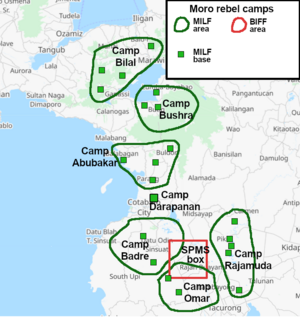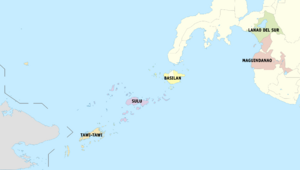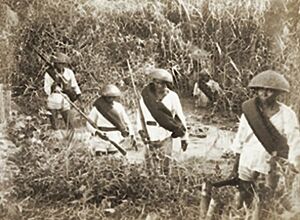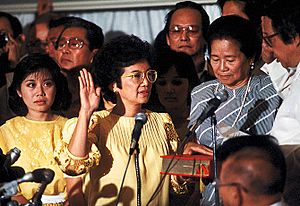Moro conflict facts for kids
Quick facts for kids Moro conflict |
||||||||||
|---|---|---|---|---|---|---|---|---|---|---|
| Part of the Cold War, Civil conflict in the Philippines, War on terror, North Borneo dispute and War against the Islamic State | ||||||||||
 Map of Moro insurgent camps in Mindanao at the time of the 2014 ceasefire |
||||||||||
|
||||||||||
| Belligerents | ||||||||||
|
Supported by: International Monitoring Team (IMT)
|
Bangsamoro
|
Jihadist groups
|
||||||||
| Commanders and leaders | ||||||||||
|
Former support:
|
|||||||||
| Strength | ||||||||||
| Unspecified | ||||||||||
| Casualties and losses | ||||||||||
| Total killed: c. 100,000 Total displaced: 2,000,000+ displaced (1970–2011) or 3,500,000+ displaced (2000–2014) |
||||||||||
| Timeline of the conflict: Timeline | ||||||||||
The Moro conflict was a long-running struggle in the Mindanao region of the Philippines. It involved different armed groups. For many years, people worked towards peace. This led to agreements between the Philippine government and two main groups: the Moro National Liberation Front (MNLF) and the Moro Islamic Liberation Front (MILF). However, some smaller armed groups still exist. In 2017, a peace council helped resolve many local disputes.
The conflict started because the Moro people have a long history of resisting foreign rule. For centuries, the region was controlled by the Spanish Empire. Later, the United States took over the Philippines in 1898 after a brief war with Spain. This led to American rule until 1946.
During the time of President Ferdinand Marcos, tensions grew between the government and Moro rebel groups. The conflict became active after the Jabidah massacre on March 18, 1968. This event involved the alleged killing of Filipino Muslim commandos. They were reportedly part of a secret plan to take over part of Sabah, a Malaysian state. Malaysia then supported the rebels, which caused much damage in the southern Philippines. This support stopped in 2001.
Many groups formed to push for Moro self-rule, either by having their own government or becoming independent. One important group was the Moro National Liberation Front (MNLF). It was started in 1972 by University of the Philippines professor Nur Misuari. The MNLF wanted to create an independent Mindanao. Later, the MNLF split, and the Moro Islamic Liberation Front (MILF) was formed by Hashim Salamat. The MILF wanted to create an Islamic state in the Philippines. In 2008, the MILF changed its goal from independence to self-rule. Some members disagreed, forming the Bangsamoro Islamic Freedom Fighters (BIFF) in 2010.
The number of people killed in the conflict varies. One study estimates that at least 6,015 people died in fighting between 1989 and 2012. This includes clashes with groups like Abu Sayyaf (ASG), BIFF, MILF, and MNLF.
Contents
- A Long History of Resistance (1500s - 1946)
- Philippine Government Policies (1946–1968)
- The Marcos Administration (1965–1986)
- Aquino and Ramos Administrations (1986–1998)
- Estrada Administration (1998–2001)
- Arroyo Administration (2001–2010)
- Benigno Aquino Administration (2010–2016)
- Duterte Administration (2016–2022)
- Bongbong Marcos Administration (2022–Present)
- See also
A Long History of Resistance (1500s - 1946)
The Moro people have fought against foreign rule for over 400 years. Spain tried many times to conquer the Moro Sultanate of Sulu and other Muslim kingdoms. But they did not succeed in the South. Moro leaders today see this struggle as a long "national liberation movement." It includes fighting against the Spanish, Americans, Japanese, and Christian Filipinos.
The roots of the modern conflict go back to the wars between Spain and the Moros, and later between America and the Moros. After the Spanish–American War in 1898, the United States took control of the Philippines. This led to another conflict in the southern Philippines from 1899 to 1913. Filipino people did not want foreign rule by the United States.
American forces took over from the Spanish in Jolo in May 1899 and in Zamboanga in December 1899. An American general, John C. Bates, signed a treaty with the Sultan of Sulu. This treaty aimed to keep the Moros neutral during the Philippine–American War. It also helped establish order in the southern Philippines. However, the treaty was mainly a way for the Americans to gain time until the war in the north ended.
The American invasion of Moro lands began in 1904. It ended during the time of Major General John J. Pershing. However, major resistance continued in places like Mount Bagsak and Bud Dajo in Jolo. In the battle at Bud Dajo, the United States military killed hundreds of Moro people. After this war, in 1915, the Americans made Sulu sign the Carpenter Treaty.
Even after the main Moro Rebellion ended, smaller rebellions against American rule continued. This lasted until the Japanese occupation of the Philippines during World War II. During the Japanese invasion, the Moros fought against the Japanese on Mindanao and Sulu. This resistance continued until Japan surrendered in 1945.
Philippine Government Policies (1946–1968)
After World War II, the Philippine government continued a policy started by the American colonial government. They encouraged many Christian Filipino settlers from other parts of the Philippines to move to Mindanao. This started in the 1920s.
By the 1970s, Christian Filipinos outnumbered both the Moro and Lumad populations. This caused more problems and disagreements over land. Another issue for the Moro people was that Mindanao's natural resources were being used by the central government. Meanwhile, many Moros remained poor.
Christian Filipino settlers often took control of important areas along new roads. This disrupted the traditional ways the Moro and Lumad people managed their lands and resources.
The Marcos Administration (1965–1986)
The Jabidah Massacre
The Moro conflict became active after news of the Jabidah massacre in March 1968. This happened near the end of President Ferdinand Marcos's first term. A senate investigation claimed that at least 11 Filipino Muslim military trainees were killed. This happened on Corregidor island by soldiers from the Armed Forces of the Philippines. The trainees were part of a secret commando unit called "Jabidah." Their mission was to secretly enter, cause problems, and take over Sabah for the Sulu Sultan. The trainees later refused their mission. A survivor said that all recruits except him were killed.
This news made Filipino Muslims very upset, especially students. Many Muslims became interested in politics. They felt that they were being treated unfairly and that they could not fit in with the rest of the country.
Early Rebel Groups
Soon, different groups formed to push for Moro self-rule or independence. Congressman Haroun al-Rashid Lucman formed the Bangsamoro Liberation Organization (BMLO). Governor Datu Udtog Matalam formed the Muslim Independence Movement (MIM). This group openly called for the region to break away and form a Muslim state. However, the MIM did not last long.
The Moro National Liberation Front (MNLF)
On October 21, 1972, University of the Philippines professor Nur Misuari formed the Moro National Liberation Front (MNLF). This group aimed to create a Moro republic through armed struggle. Many members who left the MIM joined the MNLF.
The MNLF stated that it was a secular movement, meaning it was not based on religion. This was different from the Moro Islamic Liberation Front, which formed later.
Since 1972, the MNLF has had periods of fighting and peace with the Philippine government. A peace agreement was signed in 1996 during President Fidel V. Ramos's time. However, some major clashes still happened after this agreement, like the Zamboanga City crisis in 2013.
The Siege of Jolo
In 1974, during one of the fiercest battles, Jolo was heavily damaged. News of this event made Muslims around the world pay more attention to the conflict. Many civilians were reportedly killed when the Armed Forces of the Philippines destroyed much of Jolo.
The Malisbong Massacre
On September 24, 1974, the Philippine Army killed at least 1,000 Moro civilians. This happened while they were praying in a mosque. This event is known as the Malisbong massacre.
The Tripoli Agreement
Two years later, the Philippine government and the MNLF signed the Tripoli Agreement. This agreement declared a ceasefire. It stated that Mindanao would remain part of the Philippines. However, 13 of its provinces would be governed by an autonomous government for the Bangsamoro people. President Marcos later did not follow the agreement, and violence started again.
The Ilaga Militia
The Philippine government reportedly encouraged Christian settlers in Mindanao to form a militia called the Ilaga. This group fought against the Moros. The Ilaga were involved in killings and human rights abuses. They were responsible for the Manili massacre in June 1971, where 65 Moro Muslim civilians, including women and children, were killed in a mosque.
The Moro Islamic Liberation Front (MILF)
In 1978, Sheikh Salamat Hashim formed the Moro Islamic Liberation Front (MILF). This group broke away from the MNLF. The MILF wanted to create an Islamic state. Fighting between these rebel groups and the Armed Forces of the Philippines continued until the end of President Marcos's rule. From 1972 to 1980, at least 50,000 people were killed. One million people were forced to leave their homes, and over 100,000 Philippine Muslims fled to Malaysia.
Aquino and Ramos Administrations (1986–1998)
Peace Talks and the ARMM
After becoming President, Corazon Aquino met with MNLF chairman Nur Misuari. This led to a series of peace talks. In 1989, the Autonomous Region in Muslim Mindanao (ARMM) was created. This was done under a law called the ARMM Organic Act.
During the time of President Fidel V. Ramos, more peace talks were held. The ARMM became stronger and was meant to have its own political system.
Formation of the Abu Sayyaf Group
In 1991, Abdurajak Janjalani formed the Abu Sayyaf Group. He was a former teacher who had studied Islam in the Middle East. Janjalani reportedly met Osama bin Laden in Afghanistan in the 1980s. Abu Sayyaf was a more radical group.
Estrada Administration (1998–2001)

"All Out War" Policy
President Joseph Estrada declared an "all-out war" against the MILF on March 21, 2000. However, negotiations for peace were also held. Many conflicts happened in Mindanao, and clashes between the Philippine military and rebel groups caused many deaths.
During Estrada's term, rebel groups kidnapped people and attacked towns. They also bombed a ferry and took over a highway. These incidents caused a big loss of investments in Mindanao.
The Armed Forces of the Philippines launched a successful campaign against the rebel groups. They captured many camps, including the MILF headquarters. The MILF suffered heavy losses, and its leader, Sheikh Salamat Hashim, fled. On October 5, 2000, 609 rebels surrendered. President Estrada ordered the Philippine flag to be raised in Mindanao, symbolizing victory.
Retaliatory Attacks
In response, several Islamic rebel groups carried out attacks. They bombed several key locations in Metro Manila on December 30, 2000. This resulted in 22 deaths and hundreds of injuries. Some of the people responsible were later arrested.
Arroyo Administration (2001–2010)
On May 27, 2001, the Abu Sayyaf group kidnapped twenty people from a resort in Palawan. The kidnappers then took over a hospital and a church compound in Lamitan, Basilan. They claimed to have taken 200 people captive, but 20 were confirmed.
There was a crossfire between the Philippine Army and Abu Sayyaf rebels in Lamitan. This resulted in the deaths of 12 soldiers. More soldiers were reportedly killed trying to rescue the hostages. Some captives escaped, and others were killed. The Abu Sayyaf also carried out other raids, burning buildings and taking more people captive.
On June 13, 2001, three more people were found beheaded in Basilan. This happened because the Philippine Army would not stop its rescue operation. On June 7, 2002, a rescue mission was carried out. Martin Burnham and a nurse were killed in the crossfire.
These rebel groups, especially the Abu Sayyaf, carried out several terror attacks. These included bombings in Zamboanga in 2002, a ferry bombing in 2004, and other bombings in Mindanao.
In August 2008, one thousand MILF rebels took control of 35 villages in North Cotabato province. The MILF wanted North Cotabato to be part of the Autonomous Region in Muslim Mindanao. The government and MILF had been discussing this. However, the Supreme Court rejected the idea after hearing concerns from local Christian leaders.
The rebel troops were ordered to leave the area, but they refused. The Philippine Army responded by attacking them. The next day, government forces recaptured some villages.
Between 2002 and 2015, the Philippines and the United States worked together in a military campaign against terrorism. This was part of the War on Terror.
Benigno Aquino Administration (2010–2016)
Peace Talks and Agreements
During President Benigno Aquino III's term, peace talks were held. The MILF Chair Al Haj Murad Ibrahim met with President Aquino in Tokyo, Japan. This meeting was praised by both sides. Norway also joined the International Monitoring Team (IMT) in 2011. They helped oversee the ceasefire agreement between the government and MILF in Mindanao.
Despite the peace talks, some conflicts still happened. In September 2011, a member of Abu Sayyaf was arrested after a clash. The Armed Forces of the Philippines also killed three Abu Sayyaf militants.
Terrorism continued. In January 2011, Abu Sayyaf bandits killed four merchants. In August 2011, rebel groups attacked a village in Sulu, killing seven Marines and taking civilians captive. Several areas of Mindanao were bombed by the government.
In February 2013, forces from the Moro National Liberation Front (MNLF) took over two main camps of the Abu Sayyaf group. MNLF leader Nur Misuari said this was because the MNLF opposed Abu Sayyaf's human rights abuses.
Zamboanga City Crisis
The Zamboanga City crisis started on September 9, 2013. A group from the MNLF tried to raise the flag of a self-proclaimed "Bangsamoro Republic" in Zamboanga City. They also took civilians hostage. The Armed Forces of the Philippines (AFP) and the Philippine National Police (PNP) responded. They aimed to free the hostages and remove the MNLF from the city. The situation turned into urban warfare, stopping parts of the city for days. On September 28, the government announced the end of military operations. They had defeated the MNLF and rescued all hostages.
Comprehensive Agreement on the Bangsamoro
On January 24, 2014, the Philippine government and MILF signed a peace agreement in Kuala Lumpur. This agreement aimed to create a new Muslim self-governing area called "Bangsamoro." This would happen under a new law approved by the Philippine Congress. The goal was to set up the region by 2016. The agreement called for Muslim self-rule in parts of the southern Philippines. In return, the MILF would give up their weapons to a third party. A regional police force would be created, and the Philippine military would reduce its presence. On March 27, 2014, the peace process ended with the signing of the Comprehensive Agreement on the Bangsamoro.
Abu Sayyaf and ISIL
On July 23, 2014, Abu Sayyaf leader Isnilon Hapilon declared loyalty to Abu Bakr al-Baghdadi in a video. This gave the Islamic State (ISIL) a presence in the Philippines. In September 2014, the group began kidnapping people for ransom in the name of ISIL.
Mamasapano Clash
On January 25, 2015, the Philippine National Police's Special Action Force (SAF) carried out an operation. They aimed to capture a terrorist leader in Mamasapano, Maguindanao. Forty-four SAF members were killed in what is known as the Mamasapano clash. However, they were able to eliminate the target.
In February 2015, the BIFF fought for territory. The Philippine Army and Marines then declared an "all-out-war" against the BIFF. MILF forces were pulled out to avoid being caught in the fighting.
Duterte Administration (2016–2022)
The MILF and MNLF have promised to work for peace and end the long conflict. Meanwhile, fighting against Abu Sayyaf and other groups continued in places like Jolo and Basilan. A bombing in Davao City in September 2016 killed 15 people.
Marawi Siege
On May 23, 2017, the Maute group attacked Marawi. President Rodrigo Duterte declared martial law over all of Mindanao. Clashes continued until October 2017. The battle for Marawi City involved Islamic militants fighting Philippine government forces. The government used heavy artillery and air strikes. The militant groups executed captured Christians. In 2018, two bombings happened in Lamitan and Isulan.
Bangsamoro Organic Law
On July 26, 2018, President Duterte signed the Bangsamoro Organic Law. This law replaced the Autonomous Region in Muslim Mindanao. It created the basic structure for the Bangsamoro Autonomous Region. This followed the agreements in the Comprehensive Agreement on the Bangsamoro peace deal from 2014. From June 2019 to May 2022, about 19,200 former MILF fighters gave up their weapons.
Bongbong Marcos Administration (2022–Present)
In August 2022, two armed Moro groups clashed in Cotabato City. This forced hundreds of local people to leave the area.
On September 19, 2023, a civilian was killed by a stray bullet during fighting between two rival clans. These clans were linked to the MILF.
On November 23, 2023, a member of the Moro Islamic Liberation Front was killed. Five others were wounded in explosions in Cotabato and Maguindanao del Sur.
In 2023, the government announced that Sulu province was free of Abu Sayyaf militants. In Basilan province, the government said it would build 39 houses for former Abu Sayyaf members.
In December 2023, ISIS claimed responsibility for a deadly explosion. This blast killed four people at Mindanao State University.
See also
- Communist rebellion in the Philippines
- Cross border attacks in Sabah
- Demographics of the Philippines
- Freedom of religion in the Philippines
- History of the Philippines
- Islam in Asia
- Islam in the Philippines
- Manili massacre
- Moro people
- Moro Rebellion
- Peace process with the Bangsamoro in the Philippines
- Refugees of the Philippines
- Religion in the Philippines
- Rohingya conflict
- Rohingya genocide
- South Thailand insurgency
- Spanish–Moro Wars
- Terrorism in the Philippines



